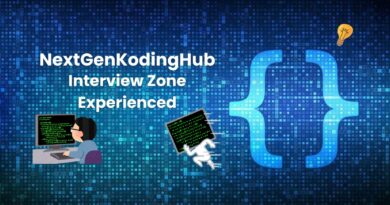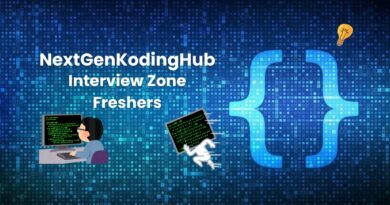Backend Developer Interviews Experienced
Interview Zone: Backend Developer Prep (Experienced)
Backend Developer Interviews Experienced – 30+ Pro-Level Questions
To succeed in senior backend engineering roles, mastering Backend Developer Interviews Experienced targets is crucial. These interviews test your knowledge of system architecture, API design, data modeling, scalability, performance, and security. Consequently, preparing for these topics builds confidence and clarity under pressure.
Moreover, answering Backend Developer Interviews Experienced questions effectively shows hiring teams your ability to design robust systems, manage stateful services, and optimize performance. Ready for the next step? Let’s dive into over 30 expert-level questions.
1. Explain REST vs. gRPC vs. GraphQL.
REST uses JSON over HTTP. gRPC uses Protobuf binary messages—ideal for inter-service efficiency. GraphQL allows clients to request only needed fields with single endpoint queries. Choose based on latency, payload size, schema complexity, and tooling support.
2. Describe API versioning strategies.
Use URL versioning (/api/v1/), header versioning, or content negotiation. Favor backward-compatible changes, timeline deprecation, and write migration guides to support legacy systems.
3. How do you design scalable microservices?
Structure microservices around bounded contexts, use communication via queues or REST, implement circuit breakers, and adopt service discovery tools (e.g., Consul). Optimize for resilience, tracing (via OpenTelemetry), and centralized logging.
4. Explain the CAP theorem in backend systems.
In distributed systems, you can choose two: Consistency, Availability, or Partition tolerance. Backend interviewers expect understanding of trade-offs—for instance, AP for social feeds and CP for financial systems.
5. How do you scale a monolith vs. microservices?
Monoliths scale vertically (bigger server) or horizontally (multiple instances behind load balancer) with shared database. Microservices scale independently per service, enabling precision autoscaling and fault isolation.
6. What are database connection pooling and limits?
Connection pooling reuses connections to reduce overhead. Configure pool size, idle timeouts, and test-on-borrow. Avoid pool exhaustion by monitoring usage and implementing queue-timeouts or back-pressure mechanisms.
7. How do you optimize database performance?
Use indexing, denormalization, query profiling, and partitioning. Implement caching layers like Redis or Memcached. Furthermore, consider read replicas and explain plans to identify slow queries.
8. Describe eventual consistency patterns.
Techniques include background reconciliation, idempotent retries, and CRDTs. Use message queues and compensation logic to maintain data integrity across services asynchronously.
9. How do you implement rate limiting?
Use token buckets, leaky buckets, Redis or in-process strategies. Choose between per-user, per-IP, or endpoint-level limits. Also, expose headers like X-RateLimit-Remaining and provide useful error messages.
10. Explain authentication vs. authorization.
Authentication verifies identity (e.g., OAuth2, JWT). Authorization determines access based on roles or resource policies. Secure JWT tokens with proper expiration and revoke flows.
11. What is the principle of least privilege?
Grant minimal permissions needed. Apply to services, database access, and cloud roles. Regularly audit and update roles to reduce blast radius.
12. How do you ensure secure transport?
Use TLS 1.2+, HTTPS, secure ciphers, and HSTS. Keep certificates updated and manage key rotation with vaults or secret platforms such as AWS Secrets Manager.
13. Describe caching strategies.
Implement cache aside, write-through, and write-behind strategies. Use TTL, shard caches, invalidate stale data proactively, and avoid cache stampede with request coalescing.
14. What is circuit breaker pattern?
Circuit Breakers (via Hystrix, Resilience4j) stop calls to failing dependencies, fallback or retry, and allow the system to self-heal. Use metrics to detect unhealthy service calls.
15. How do you design event-driven architecture?
Use message brokers (Kafka, RabbitMQ). Guarantee ordered delivery using partitions, idempotent consumers, and dead-letter queues. Also, design events as immutable, versioned payloads.
16. Explain schema migrations and version control.
Use tools like Flyway or Liquibase. Write forward and backward SQL migrations, and run them within CI/CD pipelines during deployment windows.
17. How do you monitor backend systems?
Use metrics (Prometheus, CloudWatch), distributed tracing (Jaeger), and logs (ELK, Loki). Monitor error rates, latency P95/P99, and capacity metrics (CPU, memory).
18. What is container orchestration with Kubernetes?
Use Pods, Deployments, Services, and ConfigMaps in Kubernetes. Ensure readiness and liveness probes, horizontal pod autoscaling, and rolling updates for resilience.
19. How do you build CI/CD pipelines?
Automate builds, tests, and deployments with Jenkins, GitHub Actions, or GitLab pipelines. Include code linting, unit testing, integration, and canary rollout strategies.
20. Describe logging best practices.
Use structured logging (JSON). Include trace IDs, user IDs, and contextual tags. Send logs to centralized platforms with retention policies and query tools for analysis.
21. How do you handle blue-green or canary deployments?
Deploy new versions to parallel environments, redirect traffic via load balancers, test, and rollback quickly if needed. Canary deployments route a subset of traffic to new code to verify stability.
22. Explain throttling vs queuing.
Throttling limits request rate. Queuing delays processing when systems are busy. Use back-pressure mechanisms to maintain stability under high load.
23. What are sidecar patterns and service meshes?
Sidecars (Envoy, Istio) delegate cross-cutting concerns like logging, security, and routing. Use service mesh for observability, retry logic, and mutual TLS transparently.
24. How do you implement bulk/batch processing?
Use streaming jobs (Spark, Flink) or ETL batches. Build idempotent consumers, checkpointing, and windowed aggregations for reliability and performance.
25. Describe auto-scaling strategies.
Autoscale resources using CPU/memory metrics, queue depth, or custom business indicators. Use horizontal Pod Autoscaler or Lambda scaling policies.
26. What is data partitioning and database sharding?
Partition by key (e.g., user ID). Ensure queries target specific shards to improve performance. Provide atomic writes per shard and manage cross-shard transactions carefully.
27. Explain eventual vs strong consistency again.
Plan consistency guarantees per service. Use strong consistency for payment services and eventual consistency for analytics modules to boost availability.
28. How do you manage config and secrets securely?
Store secrets in vaults like HashiCorp Vault, AWS KMS, or Azure Key Vault. Inject configs via environment variables, secure pods with service account roles, and audit changes.
29. What is CQRS and when to use it?
Command Query Responsibility Segregation separates reads and writes. Use it to optimize heavy read workloads and tune indexing/denormalization separately.
30. Describe backend testing strategies.
Unit tests for logic layers (JUnit, pytest), integration tests for DB/API endpoints, contract tests (Pact), and load tests for performance using JMeter or k6.
Bonus: What is backend caching chain?
Implement multi-layer caching (L1 in-application, L2 distributed). Use cache-aside for frequently accessed data and flush rules for coherence.
Final Thoughts
These **Backend Developer Interviews Experienced** questions challenge your architectural thinking, system design, security, and scalability skills. To reinforce your answers, build prototype systems, simulate load, and illustrate diagrams during interviews. Ultimately, practicing with real patterns and case studies will help you stand out as a senior backend engineer. Good luck—you’re ready!



